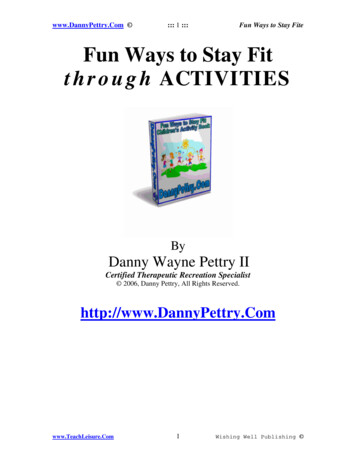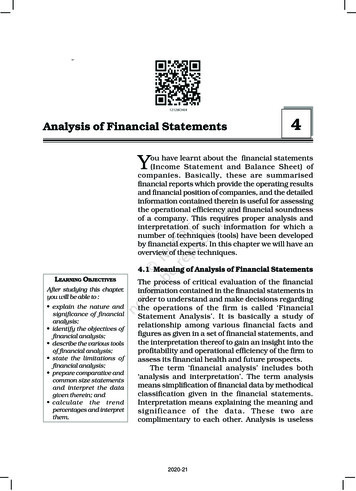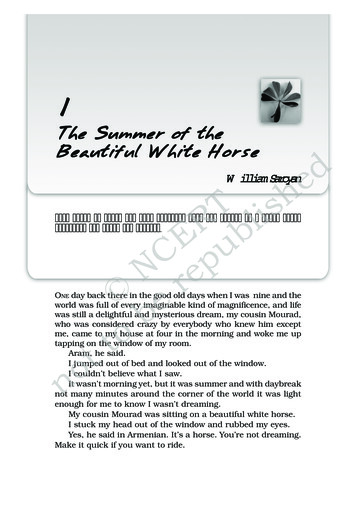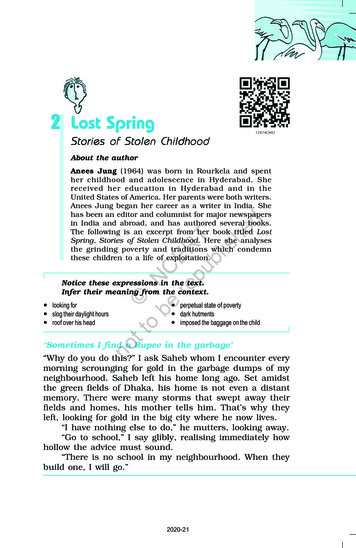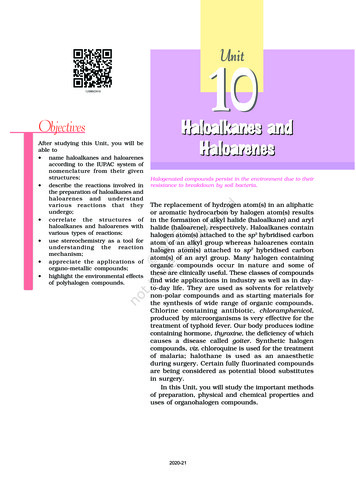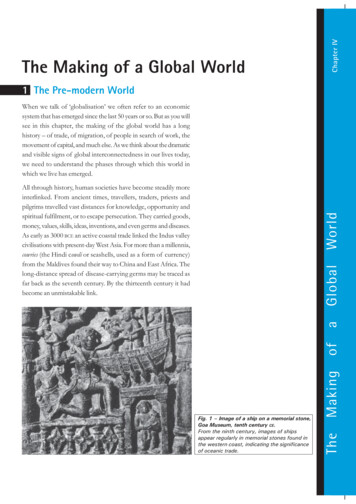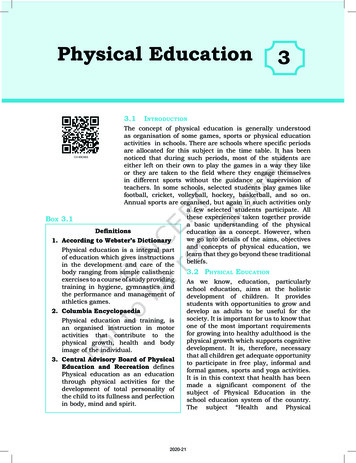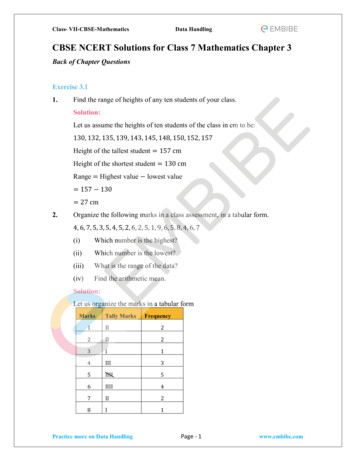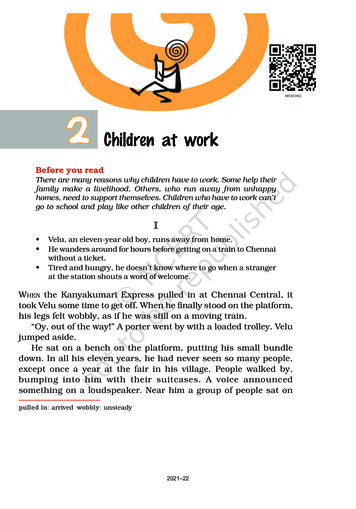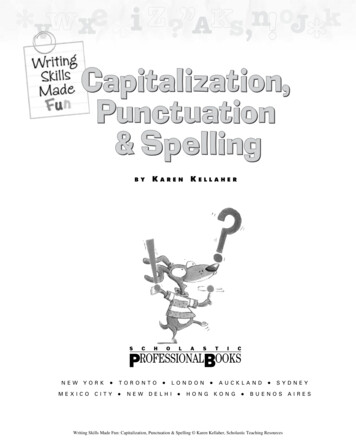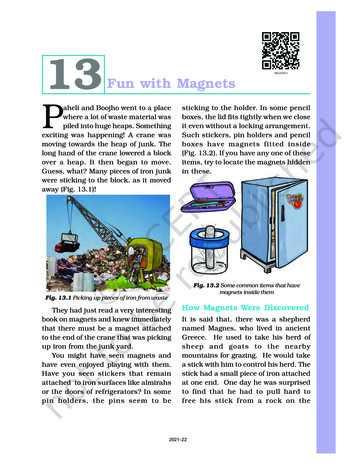
Transcription
13Fun with MagnetsPaheli and Boojho went to a placewhere a lot of waste material waspiled into huge heaps. Somethingexciting was happening! A crane wasmoving towards the heap of junk. Thelong hand of the crane lowered a blockover a heap. It then began to move.Guess, what? Many pieces of iron junkwere sticking to the block, as it movedaway (Fig. 13.1)!sticking to the holder. In some pencilboxes, the lid fits tightly when we closeit even without a locking arrangement.Such stickers, pin holders and pencilboxes have magnets fitted inside(Fig. 13.2). If you have any one of theseitems, try to locate the magnets hiddenin these.Fig. 13.2 Some common items that havemagnets inside themFig. 13.1 Picking up pieces of iron from wasteThey had just read a very interestingbook on magnets and knew immediatelythat there must be a magnet attachedto the end of the crane that was pickingup iron from the junk yard.You might have seen magnets andhave even enjoyed playing with them.Have you seen stickers that remainattached to iron surfaces like almirahsor the doors of refrigerators? In somepin holders, the pins seem to beHow Magnets Were DiscoveredIt is said that, there was a shepherdnamed Magnes, who lived in ancientGreece. He used to take his herd ofsheep and goats to the nearbymountains for grazing. He would takea stick with him to control his herd. Thestick had a small piece of iron attachedat one end. One day he was surprisedto find that he had to pull hard tofree his stick from a rock on the2021–22
Fig. 13.4 Magnets of different shapesmagnets are prepared in differentshapes. For example, bar magnet, horseshoe magnet, cylindrical or a ball-endedmagnet. Fig.13.4 shows a few suchmagnets.Fig.13.3 A natural magnet on a hillside!mountainside (Fig. 13.3). It seemed asif the stick was being attracted by therock. The rock was a natural magnetand it attracted the iron tip of theshepherd's stick. It is said that this ishow natural magnets were discovered.Such rocks were given the namemagnetite, perhaps after the name of thatshepherd. Magnetite contains iron.Some people believe that magnetite wasfirst discovered at a place calledMagnesia. The substances having theproperty of attracting iron are now knownas magnets. This is how the story goes.In any case, people now havediscovered that certain rocks have theproperty of attracting pieces of iron. Theyalso found that small pieces of theserocks have some special properties.They named these naturally occurringmaterials magnets. Later on the processof making magnets from pieces of ironwas discovered. These are known asartificial magnets. Nowadays artificialActivity 1Take a plastic or a paper cup. Fix it on astand with the help of a clamp as shownin Fig. 13.5. Place a magnet inside thecup and cover it with a paper so thatthe magnet is not visible. Attach athread to a clip made of iron. Fix theother end of the thread at the base ofthe stand. (Mind you, the trick involvedhere, is to keep the length of the threadsufficiently short.) Bring the clip nearthe base of the cup. The clip is raised inair without support, like a kite.126Fig. 13.5 Effect of magnet - a paper cliphanging in air!SCIENCE2021–22
13.1 MAGNETICMATERIALSANDNON-MAGNETICActivity 2Let us walk in the footsteps of Magnes.Only, this time, we will change thepositions of the magnet and the iron.There will be a magnet at the end of ourshepherd's stick. We can attach a smallmagnet to a hockey stick, walking stickor a cricket wicket with a tape or someglue. Let us now go out on a "Magneswalk" through the school playground.What does our "Magnes stick" pick upfrom the school ground? What aboutobjects in the classroom?Collect various objects of day-to-dayuse from your surroundings. Test thesewith the "Magnes stick". You can alsotake a magnet, touch these objects withit and observe which objects stick to themagnet. Prepare a table in yournotebook as shown in Table 13.1. andrecord your observations.Look at the last column of Table 13.1and note the objects that are attractedby a magnet. Now, make a list ofmaterials from which these objects aremade. Is there any material common inall the objects that were attracted bythe magnet?We understand that magnet attractscertain materials whereas some do notget attracted towards magnet. Thematerials which get attracted towardsa magnet are magnetic – for example,iron, nickel or cobalt. The materialswhich are not attracted towards amagnet are non-magnetic. Whatmaterials did you find to be nonmagnetic from Table 13.1? Is soil amagnetic or a non-magnetic material?Boojho has this question for you.A tailor was stitching buttons onhis shirt. The needle has slippedfrom his hand on to the floor.Can you help the tailor tofind the needle?Table 13.1 Finding the objects attracted by magnetMaterial which the object is made of(Cloth/plastic/ aluminium/ wood/glass/ iron/ any otherAttracted by Magnesstick/ magnet(Yes/No)Iron ballIronYesScalePlasticNoShoeLeather?Name ofthe object127FUN WITH MAGNETS2021–22
Activity 3Rub a magnet in the sand or soil. Pullout the magnet. Are there some particlesof sand or soil sticking to the magnet?Now, gently shake the magnet to removethe particles of sand or soil. Are someparticles still sticking to it? These mightbe small pieces of iron (iron filings)picked up from the soil.Through such an activity, we canfind out whether the soil or sand from agiven place contains particles that haveiron. Try this activity near your home,school or the places you visit on yourholidays. Does the magnet with ironfilings sticking to it, look like any oneof those shown in Fig. 13.6?Make a table of what you find.(a)If you fill this table and send it toPaheli and Boojho, they can comparethe amount of iron filings found in soilfrom different parts of the country. Theycan share this information with you.13.2 POLESOFMAGNETWe observed that iron filings (if they arepresent) stick to a magnet rubbed in thesoil. Did you observe anything specialabout the way they stick to the magnet?Activity 4Spread some iron filings on a sheet ofpaper. Now, place a bar magnet on thissheet. What do you observe? Do the ironfilings stick all over the magnet? Do youobserve that more iron filings get attractedto some parts of the magnet than others(Fig. 13.7)? Remove the iron filingssticking to the magnet and repeat the(b)(c)Fig. 13.6 Magnet with (a) many iron filings(b) few iron filings and(c) no iron filings sticking to it.Fig. 13.7 Iron filings sticking to a bar magnetTable 13.2 Magnet rubbed in sand.How many iron filings?id you find ironName of location fDilings sticking to(Colony andthe magnet?town/ city/(Many/ very few/village)none)activity. Do you observe any change inthe pattern with which the iron filingsget attracted by different parts of themagnet? You can do this activity usingpins or iron nails in place of iron filingsand also with magnets of different shapes.Draw a diagram to show the way ironfilings stick to the magnet. Is your drawingsimilar to that shown in Fig. 13.6 (a)?We find that the iron filings areattracted more towards the region close128SCIENCE2021–22
Paheli has this puzzle for you.You are given two identical barswhich look as if they might bemade of iron. One of them is amagnet, while the other is asimple iron bar. How willyou find out, which oneis a magnet?to two ends of a bar magnet. Poles of amagnet are said to be near these ends.Try and bring a few magnets of differentshapes to the classroom. Check for thelocation of the poles on these magnetsusing iron filings. Can you now mark thelocation of poles in the kind of magnetsshown in Fig. 13.4?13.3 FINDING DIRECTIONSMagnets were known to people fromancient times. Many properties ofmagnets were also known to them. Youmight have read many interestingstories about the uses of magnets. Onesuch story is about an emperor in Chinanamed Hoang Ti. It is said that he hada chariot with a statue of a lady thatcould rotate in any direction. It had anextended arm as if it was showing theway (Fig. 13.8). The statue had aninteresting property. It would rest insuch a position that its extended armalways pointed towards South. Bylooking at the extended arm of thestatue, the Emperor was able to locatedirections when he went to new placeson his chariot.Fig. 13.8 The chariot with direction finding statueLet us make such a direction finderfor ourselves.Activity 5Take a bar magnet. Put a mark on oneof its ends for identification. Now, tie athread at the middle of the magnet sothat you may suspend it from a woodenstand (Fig. 13.9). Make sure that themagnet can rotate freely. Let it come torest. Mark two points on the ground toshow the position of the ends of themagnet when it comes to rest. Draw aFig. 13.9 A freely suspended bar magnetalways comes to rest in the same direction129FUN WITH MAGNETS2021–22
line joining the two points. This lineshows the direction in which the magnetwas pointing in its position of rest. Now,rotate the magnet by gently pushing oneend in any direction and let it come torest. Again, mark the position of the twoends in its position of rest. Does themagnet now point in a differentdirection? Rotate the magnet in otherdirections and note the final directionin which it comes to rest.Do you find that the magnet alwayscomes to rest in the same direction?Now can you guess the mystery behindthe statue in the Emperor's chariot?Repeat this activity with an iron barand a plastic or a wooden scale insteadof a magnet. Do not use light objects forthis activity and avoid doing it wherethere are currents of air. Do the othermaterials also always come to rest in thesame direction?We find that a freely suspended barmagnet always comes to rest in aparticular direction, which is the NorthSouth direction. Use the direction of therising sun in the morning to find outthe rough direction towards east, whereyou are doing this experiment. If youstand facing east, to your left will beNorth. Using the Sun for findingdirections may not be very exact, but, itwill help to make out the directionNorth from the South, on your line.Using this you can figure out which endof the magnet is pointing to the Northand which points to the South.The end of the magnet that pointstowards North is called its North seekingIn which direction is the maingate of your school situated fromyour classroom?end or the North pole of the magnet. Theother end that points towards the Southis called South seeking end or the Southpole of the magnet. All magnets have twopoles whatever their shape may be.Usually, north (N) and south (S) polesare marked on the magnets.This property of the magnet is veryuseful for us. For centuries, travellershave been making use of this propertyof magnets to find directions. It is saidthat in olden days, travellers used to finddirections by suspending naturalmagnets with a thread, which theyalways carried with them.Later on, a device was developedbased on this property of magnets. It isknown as the compass. A compass isusually a small box with a glass coveron it. A magnetised needle is pivotedinside the box, which can rotate freely(Fig. 13.10). The compass also has a dial130Fig. 13.10 A compassSCIENCE2021–22
with directions marked on it. Thecompass is kept at the place where wewish to know the directions. Its needleindicates the north-south directionwhen it comes to rest. The compass isthen rotated until the north and southmarked on the dial are at the two endsof the needle. To identify the north-poleof the magnetic needle, it is usuallypainted in a different colour.13.4 MAKE YOUR OWN MAGNETThere are several methods of makingmagnets. Let us learn the simplest one.Take a rectangular piece of iron. Placeit on the table. Now take a bar magnetand place one of its poles near one edgeof the bar of iron. Without lifting thebar magnet, move it along the length ofthe iron bar till you reach the other end.Now, lift the magnet and bring the pole(the same pole you started with) to thesame point of the iron bar from whichyou began (Fig. 13.11). Move the magnetagain along the iron bar in the samedirection as you did before. Repeat thisprocess about 30-40 times. Bring a pinor some iron filings near the iron bar tocheck whether it has become a magnet.If not, continue the process for somemore time. Remember that the pole ofthe magnet and the direction of itsmovement should not change. You canalso use an iron nail, a needle or a bladeand convert them into a magnet.You now know how to make amagnet. Would you like to make yourown compass?Activity 6Magnetise an ironneedle using a barmagnet. Now, insertthemagnetisedneedle through asmall piece of cork orfoam. Let the corkfloat in water in aFig. 13.12 Abowl or a tub. Makecompass in a cupsure that the needledoes not touch the water (Fig. 13.12).Your compass is now ready to work.Make a note of the direction in whichthe needle points when the cork isfloating. Rotate the cork, with the needlefixed in it, in different directions. Notethe direction in which the needle pointswhen the cork begins to float againwithout rotating. Does the needle alwayspoint in the same direction, when thecork stops rotating?13.5 A TTRACTION AND R EPULSIONBETWEEN MAGNETSFig.13.11 Making your own magnetLet us play another interesting gamewith magnets. Take two small toy carsand label them A and B. Place a barmagnet on top of each car along itslength and fix them with rubber bands131FUN WITH MAGNETS2021–22
ABFig. 13.13 Do opposite poles attract each other?CDFig. 13.14 Repulsion between similar poles?(Fig. 13.13). In car A, keep the southpole of the magnet towards its front.Place the magnet in opposite directionin car B. Now, place the two cars closeto one another (Fig. 13.13). What do youobserve? Do the cars remain at theirplaces? Do the cars run away from eachother? Do they move towards each otherand collide? Record your observationsin a table as shown in Table 13.3. Now,place the toy cars close to each othersuch that the rear side of car A facesthe front side of car B (Fig 13.14). Dothey move as before? Note the directionin which the cars move now. Next, placethe car A behind car B and note thedirection in which they move in eachcase. Repeat the activity by placing carswith their rear sides facing each other.Record your observations in each case.What do we find from this activity?Do two similar poles attract or repel eachother? What about opposite poles — dothey attract or repel each other?This property of the magnets can alsobe observed by suspending a magnetand bringing one by one the poles ofanother magnet near it.Boojho has this question for you.What will happen if a magnet isbrought near a compass?A Few CautionsTable 13.3How do thecars move?Move towards/Position of the carsaway fromeach other/not move at allMagnets loose their properties if theyare heated, hammered or dropped fromsome height (Fig. 13.15). Also, magnetsbecome weak if they are not storedproperly. To keep them safe, barFront of car A facingthe front of car BRear of car A facingthe front of car BCar A placed behindcar BRear of car B facingrear of car AFig. 13.15 Magnets lose their property onheating, hammering and droping132SCIENCE2021–22
Fig. 13.16 Store your magnets safelymagnets should be kept in pairs withtheir unlike poles on the same side.They must be separated by a piece ofwood while two pieces of soft iron shouldbe placed across their ends (Fig. 13.16).For horse-shoe magnet, one should keepa piece of iron across the poles.Keep magnets away from cassettes,mobiles, television, music system,compact disks (CDs) and the computer.CompassMagnetMagnetiteNorth poleSouth polennnnnnMagnetite is a natural magnet.Magnet attracts materials like iron, nickel, cobalt. These are called magneticmaterials.Materials that are not attracted towards magnet are called non-magnetic.Each magnet has two magnetic poles—North and South.A freely suspended magnet always aligns in N-S direction.Opposite poles of two magnets attract each other whereas similar polesrepel one another.133FUN WITH MAGNETS2021–22
1.Fill in the blanks in the following(i) Artificial magnets are made in different shapes such as ,and .(ii) The Materials which are attracted towards a magnet are called .(iii) Paper is not a material.(iv) In olden days, sailors used to find direction by suspending a piece of.(v) A magnet always has poles.2.State whether the following statements are true or false:(i) A cylindrical magnet has only one pole.(ii) Artificial magnets were discovered in Greece.(iii) Similar poles of a magnet repel each other.(iv) Maximum iron filings stick in the middle of a bar magnet when it is broughtnear them.(v) Bar magnets always point towards North-South direction.(vi) A compass can be used to find East-West direction at any place.(vii) Rubber is a magnetic material.3.It was observed that a pencil sharpener gets attracted by both the poles of amagnet although its body is made of plastic. Name a material that might havebeen used to make some part of it.4.Column I shows different positions in which one pole of a magnet is placed nearthat of the other. Column II indicates the resulting action between them foreach situation. Fill in the blanks.Column IColumn IIN-NN -AttractionS-N- SRepulstion5.Write any two properties of a magnet.6.Where are poles of a bar magnet located?7.A bar magnet has no markings to indicate its poles. How would you find outnear which end is its north pole located?8.You are given an iron strip. How will you make it into a magnet?9.How is a compass used to find directions?10. A magnet was brought from different directions towards a toy boat that has134SCIENCE2021–22
been floating in water in a tub. Affect observed in each case is stated inColumn I. Possible reasons for the observed affects are mentioned inColumn II. Match the statements given in Column I with those in Column II.Column IColumn IIBoat gets attracted towards the magnetBoat is fitted with a magnet with northpole towards its headBoat is not affected by the magnetBoat is fitted with a magnet with southpole towards its headBoat moves towards the magnet if northpole of the magnet is brought near itsheadBoat has a small magnet fixed along itslengthBoat moves away from the magnet whennorth pole is brought near its headBoat is made of magnetic materialBoat floats without changing its directionBoat is made up non-magnetic materialSOME SUGGESTED ACTIVITIES1.Using a compass, find the direction in which windows and entrance to yourhouse or classroom open.2.Try to place two equal sized bar magnets one above the other such that theirnorth poles are on the same side. Note what happens and write yourobservations in your note book.3.Few iron nails and screws got mixed with the wooden shavings while acarpenter was working with them. How can you help him in getting the nailsand screws back from the scrap without wasting his time in searching withhis hands?4.You can make an intelligent doll, which picks up the things it likes (Fig.13.17). Take a doll and attach a small magnet in one of its hands. Cover thishand with small gloves so that the magnet is not visible. Now, your intelligentdoll is ready. Ask your friends to bring different objects near the doll's hand.Knowing the material of the object you can tell in advance whether the dollwould catch it or not.THINGS TO READFig. 13.17 An intelligent doll‘Gulliver's Travels’ which has this fantasy of the whole island of Laputa, floatingin air. Could magnets be involved?135FUN WITH MAGNETS2021–22
with the "Magnes stick". You can also take a magnet, touch these objects with it and observe which objects stick to the magnet. Prepare a table in your notebook as shown in Table 13.1. and record your observations. Look at the last column of Table 13.1 and note the objects that are attracted by a
